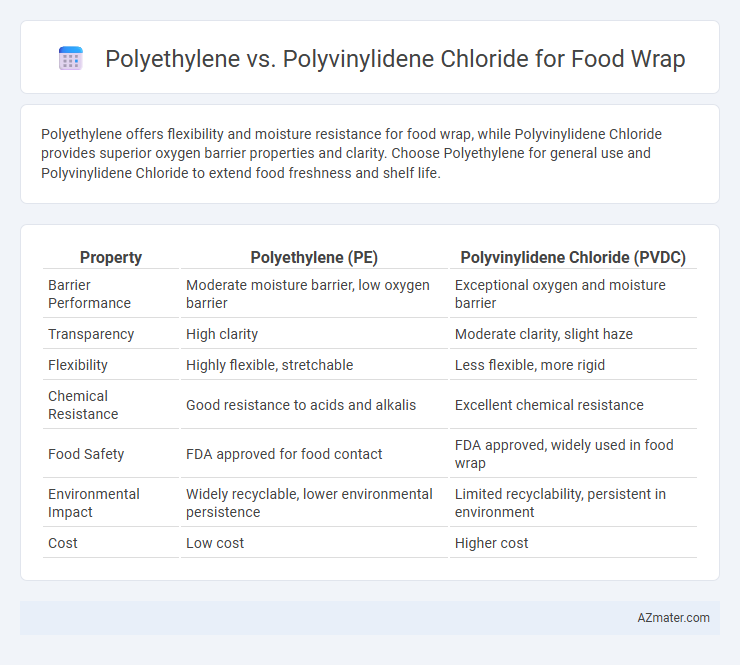Polyethylene offers flexibility and moisture resistance for food wrap, while Polyvinylidene Chloride provides superior oxygen barrier properties and clarity. Choose Polyethylene for general use and Polyvinylidene Chloride to extend food freshness and shelf life.
Table of Comparison
| Property | Polyethylene (PE) | Polyvinylidene Chloride (PVDC) |
|---|---|---|
| Barrier Performance | Moderate moisture barrier, low oxygen barrier | Exceptional oxygen and moisture barrier |
| Transparency | High clarity | Moderate clarity, slight haze |
| Flexibility | Highly flexible, stretchable | Less flexible, more rigid |
| Chemical Resistance | Good resistance to acids and alkalis | Excellent chemical resistance |
| Food Safety | FDA approved for food contact | FDA approved, widely used in food wrap |
| Environmental Impact | Widely recyclable, lower environmental persistence | Limited recyclability, persistent in environment |
| Cost | Low cost | Higher cost |
Introduction to Food Wrap Materials
Polyethylene and polyvinylidene chloride (PVDC) are two commonly used materials in food wrap applications, each offering distinct barrier properties and performance characteristics. Polyethylene provides flexibility, moisture resistance, and a cost-effective solution for general food preservation, whereas PVDC excels in oxygen and aroma barrier capabilities, extending shelf life for perishable foods. Understanding the differences in gas permeability, chemical resistance, and mechanical strength is essential for selecting the optimal food wrap material tailored to specific packaging needs.
Overview of Polyethylene (PE)
Polyethylene (PE) is a widely used polymer for food wrap due to its flexibility, transparency, and moisture resistance, making it ideal for packaging various food products. Its low cost and excellent sealing properties help maintain food freshness by preventing moisture loss and contamination. Compared to polyvinylidene chloride (PVDC), polyethylene offers superior stretchability and easier recyclability, though it provides less gas barrier protection.
Overview of Polyvinylidene Chloride (PVDC)
Polyvinylidene Chloride (PVDC) is a high-barrier polymer widely used in food wrap applications due to its exceptional resistance to moisture, oxygen, and aroma transmission. This polymer significantly extends shelf life by maintaining food freshness and preventing spoilage compared to standard Polyethylene films. PVDC's superior chemical stability and clarity make it a preferred choice for preserving delicate food products requiring airtight packaging.
Barrier Properties: Moisture and Gas Transmission
Polyvinylidene chloride (PVDC) exhibits superior barrier properties compared to polyethylene (PE), significantly reducing moisture and gas transmission rates to preserve food freshness. PVDC's low permeability to oxygen and water vapor effectively extends shelf life by preventing oxidation and spoilage, making it ideal for perishable goods. In contrast, polyethylene offers moderate moisture resistance but comparatively higher gas transmission, limiting its effectiveness in applications requiring stringent barrier performance.
Strength and Durability Comparison
Polyvinylidene chloride (PVDC) exhibits superior strength and durability compared to polyethylene (PE) when used as a food wrap, due to its higher tensile strength and excellent barrier properties against oxygen, moisture, and odors. PE is more flexible and resistant to tearing, but PVDC offers enhanced puncture resistance and better protection for food preservation over extended periods. This makes PVDC ideal for packaging perishable items requiring airtight sealing, while polyethylene suits applications needing more stretch and adaptability.
Clarity and Appearance in Food Wrapping
Polyvinylidene chloride (PVDC) offers superior clarity and a glass-like appearance compared to polyethylene (PE), making it ideal for showcasing food products with enhanced visual appeal. Polyethylene tends to have a more opaque and matte finish, which can obscure the product inside and reduce shelf attractiveness. The high transparency of PVDC film enhances consumer perception and can increase sales by maintaining the food's vibrant color and texture visibility.
Food Safety and Chemical Migration
Polyvinylidene chloride (PVDC) offers superior barrier properties against oxygen, moisture, and odors compared to polyethylene (PE), reducing the risk of food spoilage and contamination. PE is generally recognized as safe (GRAS) with minimal chemical migration, while PVDC may release trace amounts of chlorinated compounds under certain conditions, raising concerns about chemical migration into food. Food safety evaluations recommend using PVDC wraps primarily for high-fat or long-term storage foods, whereas PE is preferred for short-term use due to its lower migration potential.
Environmental Impact and Recycling
Polyethylene (PE) is widely used for food wrap due to its high recyclability and lower carbon footprint compared to Polyvinylidene Chloride (PVDC), which presents challenges in recycling because of its chlorine content leading to hazardous emissions during disposal. PVDC's non-biodegradable nature and difficulty in separation from recycling streams increase environmental impact, whereas PE can be mechanically recycled more efficiently and supports circular economy efforts. Choosing polyethylene over PVDC food wrap significantly reduces landfill waste and the release of toxic substances, making PE a more sustainable option for eco-conscious consumers and industries.
Cost and Availability
Polyethylene food wrap is widely available and typically costs less due to mass production and lower raw material expenses, making it a budget-friendly option for everyday use. Polyvinylidene chloride (PVDC) offers superior barrier properties against moisture and gases but is generally more expensive and less commonly found in stores. Businesses and consumers often choose polyethylene for cost-effectiveness and ease of access, while PVDC is preferred for specialized applications requiring enhanced preservation.
Choosing the Best Food Wrap for Your Needs
Polyethylene offers excellent flexibility and moisture resistance, making it ideal for everyday food wrapping and storage of fresh produce. Polyvinylidene chloride (PVDC) provides superior barrier properties against oxygen and odors, extending the shelf life of perishable goods like meat and cheese. Selecting the best food wrap depends on whether you prioritize cost-effective versatility or enhanced preservation for sensitive items.

Infographic: Polyethylene vs Polyvinylidene Chloride for Food Wrap
 azmater.com
azmater.com